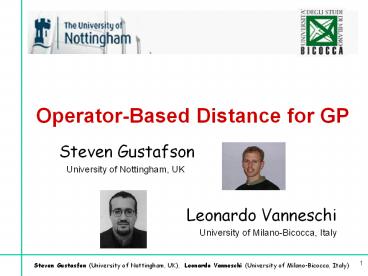Operator-Based Distance for GP - PowerPoint PPT Presentation
1 / 25
Title:
Operator-Based Distance for GP
Description:
Operator-Based Distance for GP Steven Gustafson University of Nottingham, UK Leonardo Vanneschi University of Milano-Bicocca, Italy – PowerPoint PPT presentation
Number of Views:47
Avg rating:3.0/5.0
Title: Operator-Based Distance for GP
1
Operator-Based Distance for GP
- Steven Gustafson
- University of Nottingham, UK
- Leonardo Vanneschi
- University of
Milano-Bicocca, Italy
2
Why Distance?
- analyse search space
- fitness distance correlation(s)
- diversity measures
- methods using dissimilarity
- predict convergence
- estimate similarity
3
Why Operator-Based Distance?
- operators define neighbourhood
- search only traverses neighbourhood
- non-operator-based measures inaccuracies
4
Why NOT Operator-Based?
- difficult to design
- expensive to compute
- specific for operator(s)
- accuracy gain not always clear
5
Aim of this Research
- Assess feasibility of operator-based distance
- Define approximations schemes that are
- more specific than standard distance measures
- less complex than "true" operator distance
6
Assumptions
- GP using syntax trees
- only operator is subtree crossover
- Edit distance
- number of node additions/deletions/changes to
make two trees equal
7
Standard Edit Distance
- complexity between two trees
- O(k) (k nodes in trees)
- pair-wise distance in population
- O(M2 k) (where M is
population size) - for a metric space
- M(M-1)/2 (comparisons)
- O(M k) with preprocessing
8
Further Assumptions
- Subtree crossover replaces a subtree in the
parent with a donors subtree - The "true" distance between two trees is the
algorithmic distance, according to operators (and
other algorithm properties)
9
Some Notation
- P is population with M trees
- T1 is parent tree
- T2 is the tree to transform T1into
- T1/T2 is the "difference" between trees
- T1/T2 ? (st1, st2)
- where st2 must replace st1 in
- T1 to make T1equal toT2
10
OpBD. Overview
- if T1 is in P, then the distance value depends on
finding st2 in P - if st2 is not in P, then the distance value
depends on creating st2 with other operations - distances greater than 1 require simulating
possible future operations and populations
11
OpBD Problems
- distance based on simulation of future
populations and operations is not exact - accuracy is lost with these simulations
- can we find a balance?
12
Probabilistic OpBD
- provide confidence bound with distance?
- complicated
- only consider distances of 0 and 1?
- reflective of generational and steady-state
- treat "distance" as a probability!
- incorporate other algorithm and representation
properties to increase accuracy
13
Subtree Crossover Distance
- distance (T1,T2,V,P)
- begin
- (st1,st2) T1/T2
- ps1 probSelecting (st1,T1)
- ps2 probCreating (st2,P)
- return (ps1ps2)
- end
14
SXO-OpBD Complexity
- T1/T2 is linear time in size of T1 and T2
- probSelecting is linear time of size of T1
- probCreating is O(M k)
- pair-wise distance for P is in O(M3 k3)
- preprocessing P can reduce complexity
15
Complexity Reduction
- incorporate algorithm features
- reduce complexity but maintain accuracy
- only consider subtrees in solutions that are
likely to be selected (highly fit) - linear time in M, once for pair-wise distances of
population
16
More Complexity Reduction
- only consider subtrees likely to be selected by
subtree crossover (according to size) - consider fit solutions and likely subtrees
- tune these two approximations for "appropriate"
levels
17
The GP System
- steady-state
- M 20
- primitives are empty
- two-node "join" function
- tournament selection, size 3
- new solution replaces worst in P
- 500 generations (operator applications)
18
The Problem
- based on Tree-String - only structure
- generate a tree shape to make an instance
- fitness is the absolute difference between number
of nodes at each depth between instance tree
shape and candidate solution - 30 random instances,
- 30 GP runs on each instance
19
Example
20
Distance and Complexity
- occurrences of missing subtree st2 in P over the
number of subtrees in the population - roughly, the likelihood of selecting st2
21
Pair-wise Variations
22
Complexity Variations
23
Memory Requirements
24
Conclusions
- addressed the gap between distance measures and
"true algorithmic distance" - formulated specific operator-based distance for
GP syntax trees and subtree crossover - considered complexity reduction methods
- demonstrated some properties of an operator-based
distance and edit distance
25
Future Work
- applying operator-based distance to other
problems - tuning the complexity reduction methods
- evaluating accuracy
- incorporating operator-based distance into
- fitness distance correlation research (Leonardo)
- diversity measure and method research (Steven)































